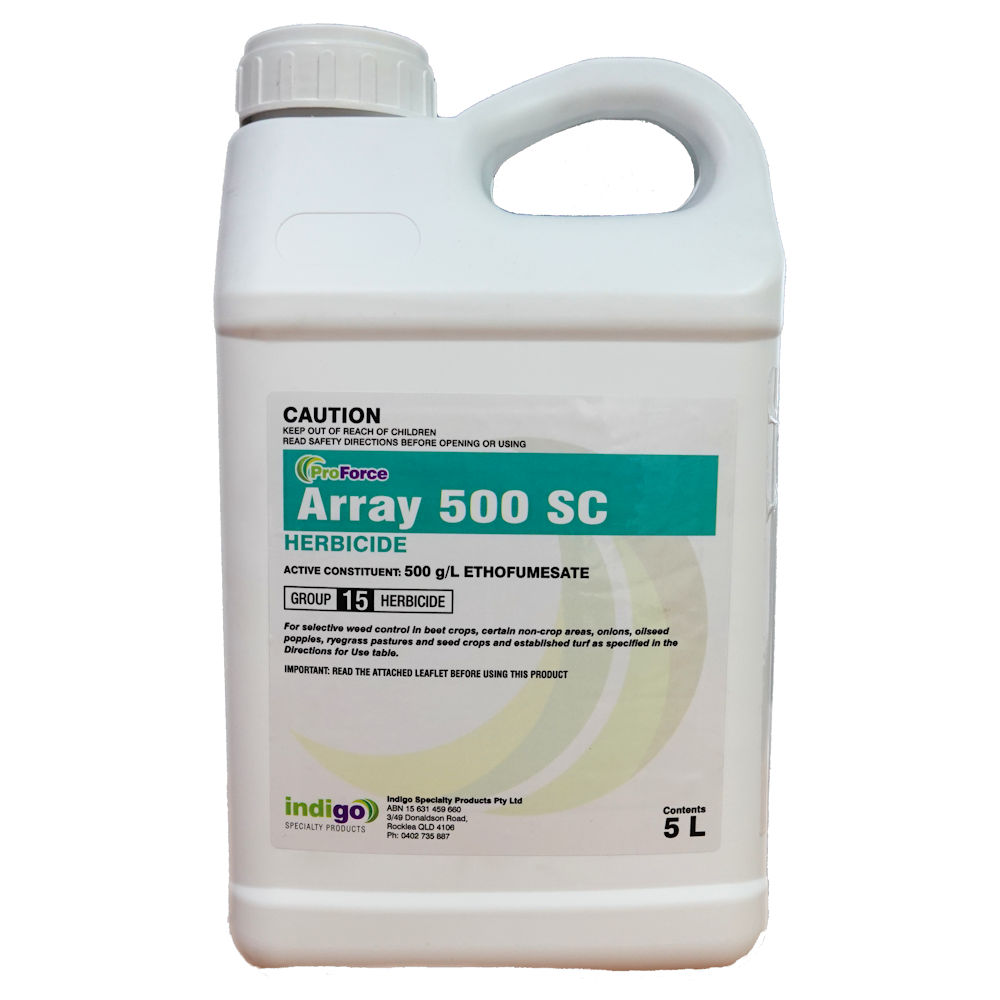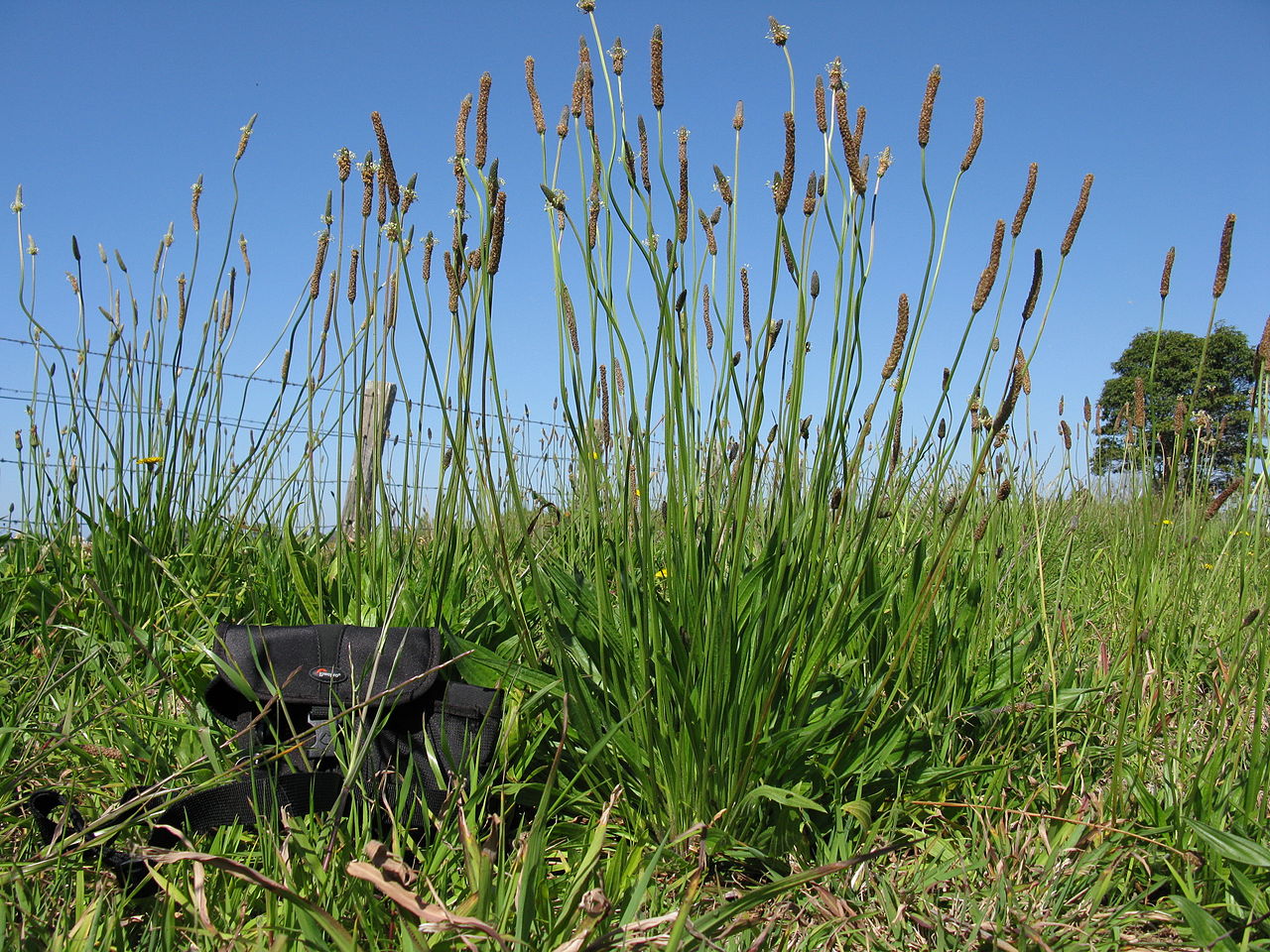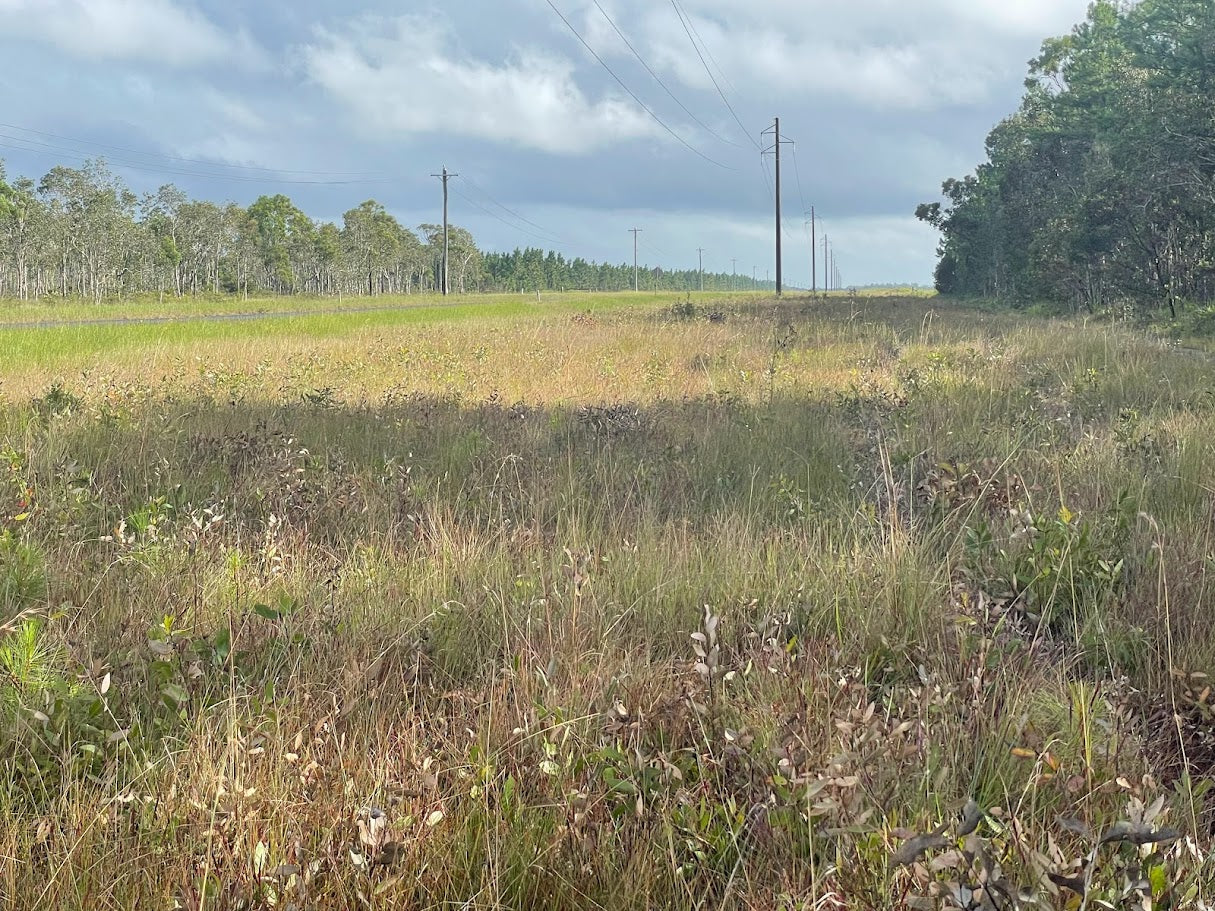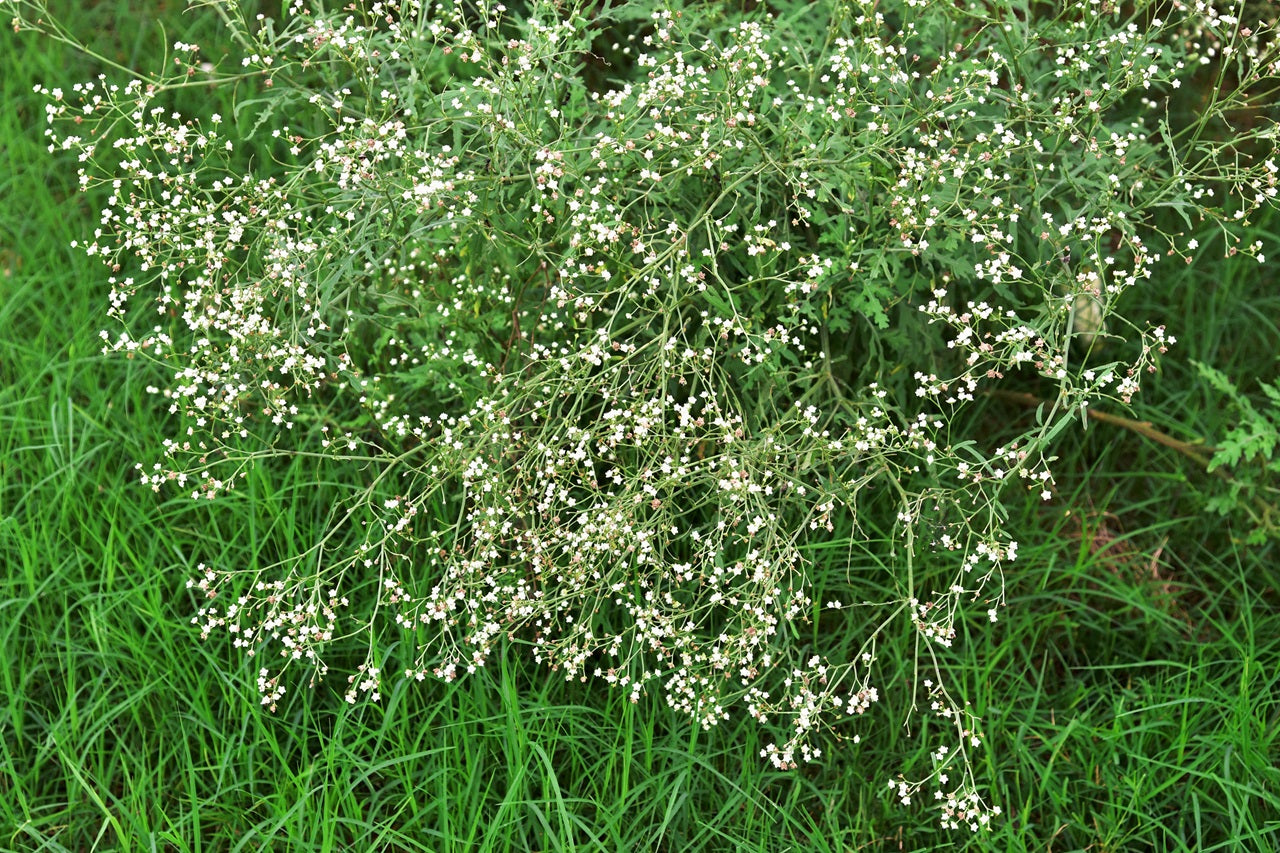
Indigo Array Herbicide 5L. Ethofumesate
Group 15 Herbicide
ProForce Array 500 SC Herbicide is a pre and postemergent herbicide containing 500g/L of the active ingredient Ethofumesate. It is registered for the pre-emergent control of Wintergrass in a variety of turfgrasses including Bentgrass, Kentucky Bluegrass, Kikuyu, Queensland Blue Couch and Ryegrass. ProForce Array 500 SC is also registered for the control of a range of grass and broadleaf weed species in noncrop situations including fencelines and tree plantations.
Key Features
- Pre and Post-emergent activity. Ultimate application versatility. Array can be used prior to, at or after, following weed germination.
- Excellent safety on cool season turfgrasses as well as Kikuyu and Qld Blue Couch. Very safe to key turfgrass species that Array is labelled to be used on.
- Unique mode of action Group. Excellent rotational tool from a resistance management perspective.
- Flexibility around re-seeding of cool season grasses. Excellent safety around overseeding cool season grasses, particularly Ryegrass.
- Also registered for use in non-crop situations. Can be a useful rotational option for fenceline management or tree plantations as specified on the label.
- Has activity on difficult to control weeds including Barley Grass and Brome Grass. Provides versatility on a range of weed species.
Maximising Performance:
Turfgrass Selectivity
Perennial ryegrass is considered to be the safest turfgrass to Array (ethofumesate) treatments. Previous research conducted has determined plant safety to ethofumesate in the descending order of tolerance as below:
> Perennial ryegrass > Tall fescue > Creeping bentgrass > Kentucky bluegrass > Wintergrass. (Adams, 1989)
Array is also safe for use on Kikuyu and Qld Blue Couch turf species.
Array is NOT SAFE on Couch and Hybrid Couch turf surfaces.
Soil Residual Activity
Array has been shown not to leach in soils that have an organic matter content greater than 1%. Soil microorganisms are responsible for the degradation of ethofumesate in soils. The soil persistence of ethofumesate is affected by climate, soil type and microbial activity. Under warm, moist conditions and cold, dry conditions the half-life of ethofumesate is 5 and 14 weeks, respectively.
Weeds Controlled
BROADLEAF WEEDS
- Chickweed (Stellaria media)
- Cleavers (Galium aparine)
- Fat-hen (Chenopodium album)
- Fumitory (Fumaria officinalis)
- Redshank (Amaranthus retroflexus)
- Shepherd’s Purse (Capsella bursa-pastoris)
- Storksbill (Erodium spp.)
- Clovers (Trifolium spp.)
- Cruciferous Weeds (Brassicaceae family)
- Patterson’s Curse (Echium plantagineum)
GRASSY WEEDS
- Barley Grass (Hordeum leporinum)
- Prairie Grass (Bromus catharticus)
- Summer Grass (Digitaria sanguinalis)
- Winter Grass (Poa annua)
- Wireweed (Polygonum aviculare)
- Brome Grass (Bromus spp.)
These weeds are controlled in beet crops, oilseed poppy, onions, ryegrass pastures, non-crop areas, and turf when ProForce Array 500 SC is applied as directed on the label.
Mode of Action
Ethofumesate, the active ingredient in ProForce Array 500 SC Herbicide is absorbed by young shoots and roots of susceptible weed species. The post emergence activity of ethofumesate is limited to very young weeds at lower use rates, as ethofumesate is not absorbed by leaves after the plant has produced a mature cuticle. Ethofumesate is translocated within the plant following coleoptile or root absorption but is not translocated out of treated leaves. Ethofumesate is believed to inhibit photosynthesis and respiration within the susceptible weed species.
SHORT DESCRIPTION
ProForce Array 500 SC Herbicide is a selective pre- and post-emergent herbicide for controlling broadleaf and grassy weeds in beet crops, turf, onions, ryegrass pastures, and non-crop areas. It provides effective residual control and is safe for use on a range of turf species.
ACTIVE INGREDIENTS
500g/L Ethofumesate
APPLICATION INFORMATION
APPLICATION INFORMATION AND RATES – PROFORCE ARRAY 500 SC HERBICIDE
Beet Crops (Beetroot, Fodder Beet, Mangolds, Sugar Beet)
Weeds Controlled: Barley Grass, Chickweed, Cleavers, Fat-hen, Fumitory, Prairie Grass, Redshank (Amaranthus spp.), Shepherd’s Purse, Summer Grass, Winter Grass, Wireweed
States: Qld, NSW, ACT, Vic, Tas, SA
Rate: 4 or 6 L/ha (pre-emergence)
Critical Comments: Apply before crop and weeds emerge. Use the higher rate on heavy soil or if Amaranthus spp., Prairie Grass or Wireweed are a problem. Do not re-treat area at these rates.
Rate: 2 L/ha plus 5 L Betanal/ha (post-emergence)
Critical Comments: Apply at crop 2 to 4 leaf stage and when weeds are at 2 to 4 leaf stage. Apply as a band or overall spray. Do not spray with high pressure or onto wet beet foliage.
Oilseed Poppy
Weeds Controlled: Barley Grass, Clovers, Cruciferous Weeds, Fat-hen, Fumitory, Winter Grass, Wireweed
State: Tasmania
Rate: 400 mL to 2 L/ha
Critical Comments: Use in spray programs with other herbicides as recommended by poppy contractors or the Department of Primary Industry. Do not add wetting agent.
Onions
Weeds Controlled: Barley Grass, Clovers, Cruciferous Weeds, Fat-hen, Fumitory, Winter Grass, Wireweed
State: Tasmania
Rate: 600 mL to 1.2 L/ha
Withholding Period: 13 weeks
Critical Comments: Apply after 2 leaf stage. Do not add wetting agent. Follow with recommended herbicide programs.
Rate: 1 to 1.2 L/ha plus 2.8 kg a.i. chlorpropham/ha
Critical Comments: Use only under guidance from authorities or contractors. Apply after 2 leaf stage. Do not add wetting agent.
Ryegrass Pasture And Seed Crops, Non-Crop Areas (Stock Camps, Tree Plantations, Fence Lines)
Weeds Controlled: Barley Grass, Cleavers, Brome Grass (emerged), Seedling Chickweed, Shepherd’s Purse, Storksbill, Winter Grass
States: Vic, Tas
Rate: 3 L/ha
Withholding Period: 7 days
Critical Comments: Apply from April to July to moist soil after main germination of Barley Grass. Do not apply once Barley Grass reaches green flowerhead stage. Do not treat pastures where clover production is important. Use when rainfall is 250–750 mm, pasture height is less than 5 cm, and soil organic matter is under 10%.
Rate: 4 L/ha
Critical Comments: Use when rainfall exceeds 750 mm, pasture is 5–10 cm high, and dung is present.
Spot Treatment
Rate: 300 mL per 100 L water
Critical Comments: Apply with handgun or knapsack sprayer. Wet vegetation thoroughly.
Established Turf (Bent Grasses including Brown Top Bent, Kentucky Bluegrass, Kikuyu, Queensland Blue Couch, Ryegrass)
Weed Controlled: Winter Grass (Poa annua)
States: NSW, ACT, Vic, Tas, SA, WA
Rate: 800 mL in 400–600 L water/ha or 8 mL in 4–6 L water per 100 m²
Withholding Period: Do not graze or feed clippings to animals
Critical Comments: Apply one month before expected autumn germination, between February and April (up to May in northern NSW). Repeat monthly for 3–4 months. Watering improves residual action. Avoid mowing shortly before or after application. Avoid overlapping and excessive run-off. Do not add surfactants or other herbicides unless recommended.
WEEDS CONTROLLED
WEEDS CONTROLLED – PROFORCE ARRAY 500 SC HERBICIDE
BROADLEAF WEEDS
Chickweed (Stellaria media)
Cleavers (Galium aparine)
Fat-hen (Chenopodium album)
Fumitory (Fumaria officinalis)
Redshank (Amaranthus retroflexus)
Shepherd’s Purse (Capsella bursa-pastoris)
Storksbill (Erodium spp.)
Clovers (Trifolium spp.)
Cruciferous Weeds (Brassicaceae family)
Patterson’s Curse (Echium plantagineum)
GRASSY WEEDS
Barley Grass (Hordeum leporinum)
Prairie Grass (Bromus catharticus)
Summer Grass (Digitaria sanguinalis)
Winter Grass (Poa annua)
Wireweed (Polygonum aviculare)
Brome Grass (Bromus spp.)
These weeds are controlled in beet crops, oilseed poppy, onions, ryegrass pastures, non-crop areas, and turf when ProForce Array 500 SC is applied as directed on the label.
PRODUCT LABEL SUMMARY
Full Product Label Summary – ProForce Array 500 SC Herbicide
Product Name
ProForce Array 500 SC Herbicide
APVMA Approval Number
69025/146574
Signal Headings
Caution
Keep out of reach of children
Read safety directions before opening or using
Constituent Statements
500 g/L Ethofumesate
Mode of Action
Group 15 Herbicide
Statement of Claims
For selective weed control in beet crops, certain non-crop areas, onions, oilseed poppies, ryegrass pastures and seed crops, and established turf as specified in the Directions for Use table.
Net Contents
5 L to 20 L
Restraints
Do not apply if rain is imminent or falling
Do not rotate with crops other than beet crops for 6 months after application
Spray Drift Restraints
Do not apply if wind speed is not between 3 and 15 km/h
Do not apply during surface temperature inversion
Avoid spray drift to sensitive vegetation and commodities
Keep bystanders away from spray cloud
Directions For Use
Refer to full label for crop-specific rates and timing
Withholding Periods
Onions – Do not harvest for 13 weeks after application
Ryegrass pasture and seed crops – Do not graze or cut for stock food for 7 days after application
Turf – Do not graze treated areas or feed lawn clippings to animals
General Instructions
Pre- and post-emergence herbicide for broadleaf and grass weed control
Apply post-emergence when weeds are at seedling to 4-leaf stage
Do not spray beet crops when foliage is wet
Mix only enough for immediate use
In turf, apply monthly for 3–4 months before and during winter grass emergence
Do not overseed turf for one month after spraying
Mixing
Invert or roll container before opening
Mix with clean water and agitate well
Add Betanal only if directed
Do not add other herbicides or surfactants unless specifically advised
Application
Boom spray – Use fine spray at 200–300 kPa
Ensure even coverage and correct nozzle height
Clean equipment thoroughly after use
Resistance Warning
Group 15 herbicide
Contains a fat synthesis inhibitor (not an ACCase inhibitor)
Resistance may develop if used repeatedly on the same weed population
No liability accepted for resistance-related control failure
Protection Of Crops, Native And Non-Target Plants
Do not allow spray drift onto non-target vegetation
Protection Of Wildlife, Fish, Crustaceans And Environment
Do not contaminate watercourses during use or disposal
Storage And Disposal
Store in a cool, dry, well-ventilated area, away from sunlight
Triple rinse containers before disposal
Recycle or dispose of containers as per local regulations
Do not burn product or containers
Safety Directions
May irritate eyes and skin
Avoid contact with eyes and skin
Wash hands after use
First Aid
If poisoning occurs, contact a doctor or Poisons Information Centre (Australia: 13 11 26)
LABEL, SDS & TECH SHEET
SHIPPING & RETURNS
Greenway Weed Solutions has a distribution centre in QLD only. All orders, Australia-wide will be shipped from this location.
Shipping is free on all online orders. Bulk purchase shipping rates are determined by total order weight and delivery location.
Pickups are available from the QLD warehouse. Updates to product availability in other Australian warehouses are upcoming.
Choose options

explore our latest Blogs

Water pH and the Performance of Weak Acid Herbicides
Weak-acid herbicides must remain in their non-ionised (acid) form to move efficiently through the plant cuticle. When spray water is too alkaline, the herbicide molecule becomes ionised.
Read more
Towards Modern Vegetation Management: Solutions for Australia’s Linear Infrastructure
Understanding the Changing Vegetation Challenge Vegetation management across Australia’s linear infrastructure corridors is becoming increasingly complex. Roads, rail corridors, gas pipelines, elec...
Read more
Case Study: Parthenium Weed Hygiene
Introduction: The Necessity of Weed Hygiene Management Australia’s vast expanses and diverse land uses, from grazing pastures and cropping zones to natural bushland and urban corridors are u...
Read more
